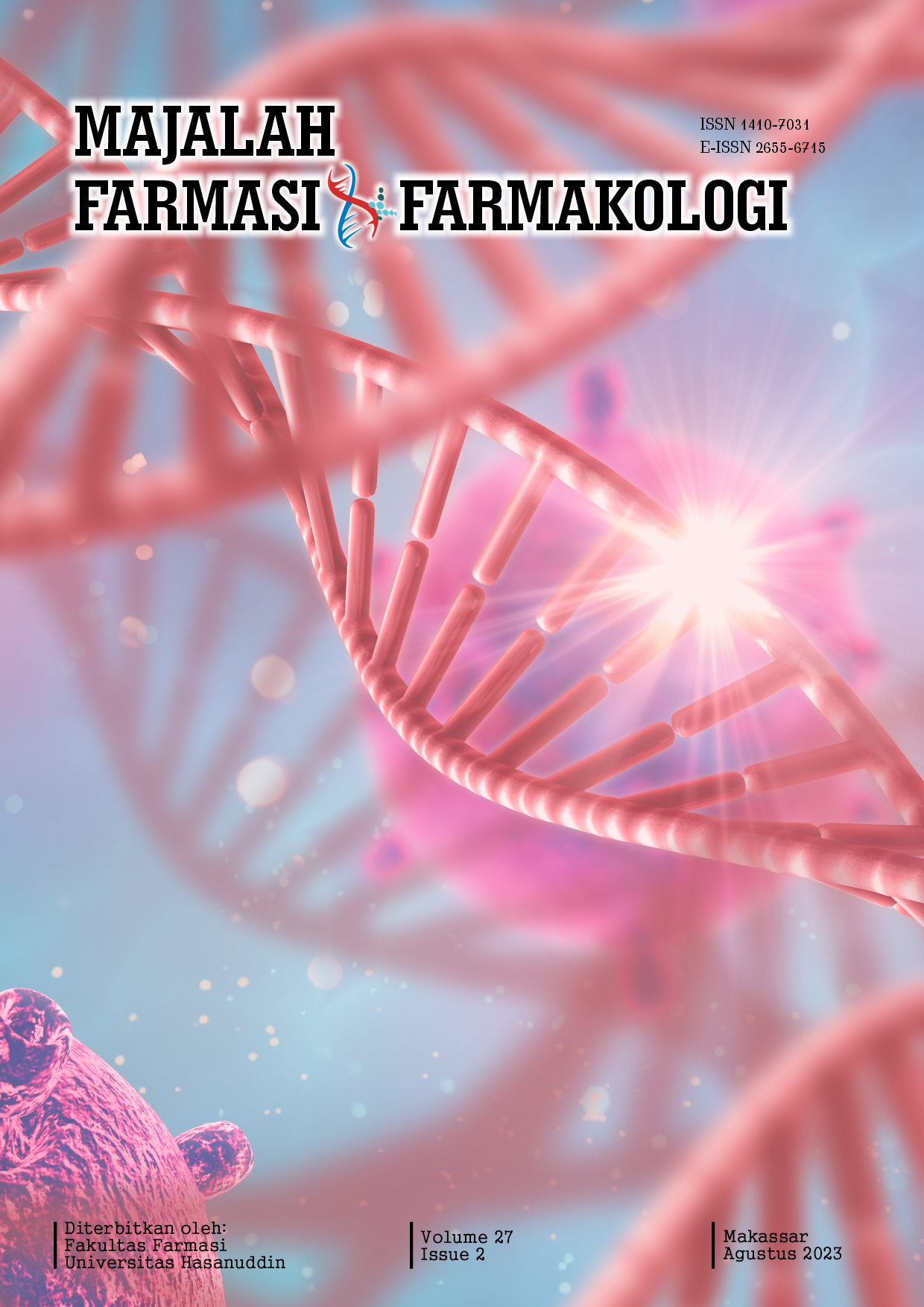PREDIKSI TOKSISITAS SENYAWA JAMU ANTI-HIPERTENSI DENGAN RESEPTOR ANGIOTENSIN II TIPE 1 (AGTR1) SECARA IN SILICO
Keywords:
Antihipertensi, in silico, jamu, penambatan, toksisitas.Abstract
Penggunaan jamu antihipertensi dimasyarakat merupakan salah satu pengobatan hipertensi. Kombinasi tanaman sebagai antihipertensi terdiri dari Imperatae rhizoma, Centella herba, Pyllanthi herba, Orhosiphonis folium, Curcumae rhizoma, dan Apii graviolentis. Jamu diketahui bekerja secara sinergis pada banyak reseptor, salah satunya adalah reseptor AGTR1. Sebagai skrining awal keamanan jamu antihipertensi dilakukan prediksi toksisitas berdasarkan interaksinya pada reseptor. Penelitian ini bertujuan memprediksikan interaksi senyawa jamu antihipertensi terhadap reseptor AGTR1 (PDB ID: 4ZUD) dan memprediksi toksisitas senyawa dengan interaksi terbaik secara in silico. Terdapat 196 senyawa dalam jamu antihipertensi yang akan diskrining menggunakan parameter Lipinski’s Rule of Five (ROF). Autodock 4.2 digunakan untuk memprediksi interaksi 126 senyawa yang memenuhi ROF. Dari hasil penambatan diperoleh 14 senyawa dan diambil 5 senyawa dengan interaksi terbaik untuk diprediksikan toksisitas akut dengan nilai LD50 dan toksisitas kronisnya dengan parameter, karsinogen, mutagen, hepatotoksik, dan nefrotoksik menggunakan tools Ochem, Protox II, dan Toxtree. Berdasarkan hasil penelitian menunjukan senyawa dengan interaksi terbaik adalah alnustone, hinokinin, nirtetralin, 3-O-cis-p-coumaroylkaempferol, dan hypophyllanthin. Hypophyllanthin memiliki interaksi terbaik dengan nilai konstanta inhibisinya 3,16 µM, energi bebas Gibbs (∆G) -7,5 kkal/mol, dan berikatan dengan 12 asam amino. Dari kelima senyawa tidak ada yang bersifat hepatotoksik; Senyawa alnustone diprediksi karsinogen mutagen; senyawa alnustone dan 3-O-cis-p-coumaroylkaempferol diprediksi nefrotoksik; serta senyawa hypophyllanthin dan nirtetralin diprediksi toksik dengan nilai LD50 500 mg/kg.References
D. M. Lloyd-Jones, Hypertension: A Companion to Braunwald’s Heart Disease, 3rd ed. Philadelphia: Elsevier, 2017. doi: 10.1016/c2015-0-01752-x.
Anies, Penyakit Degeneratif: Mencegah dan Mengatasi Penyakit Degeneratif dengan Perilaku dan Pola Hidup Modern yang Sehat, 1st ed. Yogyakarta: Ar-Ruzz Media, 2018.
World Health Organization, “Hypertension: What is Hypertension?,” 2021. https://www.who.int/news-room/fact-sheets/detail/hypertension (accessed Mar. 11, 2022).
Kementerian Kesehatan RI, “Hipertensi Penyakit Paling Banyak Diidap Masyarakat,” Biro Komunikasi dan Pelayanan Masyarakat, Kementerian Kesehatan RI, 2019. https://www.kemkes.go.id/article/view/19051700002/hipertensi-penyakit-paling-banyak-diidap-masyarakat.html (accessed Mar. 11, 2022).
S. Steddon, A. Chesser, J. Cunningham, and N. Ashman, Oxford Handbook of Nephrology and Hypertension. 2014. doi: 10.1093/med/9780199651610.001.0001.
Y. G. Tedla and L. E. Bautista, “Drug Side Effect Symptoms and Adherence to Antihypertensive Medication,” Am. J. Hypertens., vol. 29, no. 6, pp. 772–779, 2016, doi: 10.1093/ajh/hpv185.
O. Adi Parwata, “Obat Tradisional,” Bali, 2016.
N. Laili, Terapi Alternatif Komplementer pada Pasien Hipertensi dalam Perspektif Keperawatan. Yogyakarta: Deepublish, 2020.
K. E. Bernstein, J. F. Giani, X. Z. Shen, and R. A. V. Gonzalez, “Renal angiotensin-converting enzyme and blood pressure control,” NIH Public Access, vol. 23, pp. 106–112, 2014.
J. T. Dipiro, G. C. Yee, L. M. Posey, S. T. Haines, T. D. Nolin, and V. Ellingrod, Pharmacotherapy: A Pathophysiologic Approach, 11th Edition, 11th ed., vol. 40, no. 9. McGraw Hill, 2020. doi: 10.1345/aph.1h160.
H. Zhang et al., “Structure of the angiotensin receptor revealed by serial femtosecond crystallography,” Cell, vol. 161, no. 4, pp. 833–844, 2015, doi: 10.1016/j.cell.2015.04.011.
Supriyatna, Moelyono, Y. Iskandar, and R. M. Febriyanti, Mengenal Obat Herbal: Pemahaman Obat Herbal Untuk Fitoterapi. Bandung: Unpad Press, 2013.
S. Paramita, R. Isnuwardana, M. K. Nuryanto, R. Djalung, D. G. Rachmawatiningtyas, and P. Jayastri, “POLA PENGGUNAAN OBAT BAHAN ALAM SEBAGAI TERAPI KOMPLEMENTER PADA PASIEN HIPERTENSI DI PUSKESMAS,” J. Sains dan Kesehat., vol. 1, no. 7, pp. 367–376, Jun. 2017, doi: 10.25026/jsk.v1i7.56.
U. Nisa, U. Fitriani, and E. Wijayanti, “The activities of Indonesian bay-leaves, centella herbs, blady-grass roots and nutmeg seeds as herbal formulation hypertensive rats induced by prednisone and salt,” J. Kefarmasian Indones., vol. 7, no. 2, pp. 87–94, 2017.
I. Ahmad, “Molecular Docking Studies of Active Compounds from Phyllanthus niruri with Angiotensin-Converting Enzyme Inhibition,” vol. 14, no. 58, 2019.
Emelda, “TOKSISITAS KUMIS KUCING (Orthosiphon stamineus) SEBAGAI ANTI HIPERTENSI,” J. Kefarmasian Akfarindo, vol. 2, pp. 13–18, 2017, [Online]. Available: http://jofar.afi.ac.id/index.php/jofar/article/view/16
S. S. Al Disi, M. A. Anwar, and A. H. Eid, “Anti-hypertensive herbs and their mechanisms of action: Part I,” Front. Pharmacol., vol. 6, pp. 1–24, 2016, doi: 10.3389/fphar.2015.00323.
H. L. Gao et al., “Apigenin Improves Hypertension and Cardiac Hypertrophy Through Modulating NADPH Oxidase-Dependent ROS Generation and Cytokines in Hypothalamic Paraventricular Nucleus,” Cardiovasc. Toxicol., vol. 21, no. 9, pp. 721–736, 2021, doi: 10.1007/s12012-021-09662-1.
M. W. Winarno, L. Widowati, and D. Sundari, “Studi Keamanan Ramuan Jamu untuk Hiperurisemia dan Hipertensi,” Bul. Penelit. Kesehat., vol. 43, no. 3, 2015, doi: 10.22435/bpk.v43i3.4341.137-146.
A. Triyono, Z. Zulkarnain, and T. A. Mana, “Studi Klinis Ramuan Jamu Antihipertensi pada Pasien Hipertensi Derajat I,” 2018. doi: 10.22435/jki.v8i1.6443.17-25.
M. Rahayu and M. F. Solihat, Toksikologi Klinik, vol. 7, no. 1. Jakarta: Kementerian Kesehatan RI, 2018. [Online]. Available: https://www.researchgate.net/publication/269107473_What_is_governance/link/548173090cf22525dcb61443/download%0Ahttp://www.econ.upf.edu/~reynal/Civil wars_12December2010.pdf%0Ahttps://think-asia.org/handle/11540/8282%0Ahttps://www.jstor.org/stable/41857625
M. Al-Naimi, H. Rasheed, N. Hussien, H. Al-Kuraishy, and A. Al-Gareeb, “Nephrotoxicity: Role and significance of renal biomarkers in the early detection of acute renal injury,” J. Adv. Pharm. Technol. Res., vol. 10, no. 3, pp. 95–99, 2019, doi: 10.4103/japtr.JAPTR_336_18.
N. G. Bakhtyari, G. Raitano, E. Benfenati, T. Martin, and D. Young, “Comparison of in silico models for prediction of mutagenicity,” J. Environ. Sci. Heal. - Part C Environ. Carcinog. Ecotoxicol. Rev., vol. 31, no. 1, pp. 45–66, 2013, doi: 10.1080/10590501.2013.763576.
S. Y. Pan et al., “New perspectives on how to discover drugs from herbal medicines: CAM’S outstanding contribution to modern therapeutics,” Evidence-based Complement. Altern. Med., vol. 2013, 2013, doi: 10.1155/2013/627375.
V. Aprilla Handayani, F. Mochamad Afendi, and W. Ananta Kusuma, “Penguraian Mekanisme Kerja Jamu Berdasarkan Jejaring Bahan Aktif-Protein Target-Gene Ontology,” J. Jamu Indones., vol. 1, no. 3, pp. 18–28, 2016, doi: 10.29244/jjidn.v1i3.30640.
K. Sachdev and M. K. Gupta, “A comprehensive review of feature based methods for drug target interaction prediction,” J. Biomed. Inform., vol. 93, no. November 2018, p. 103159, 2019, doi: 10.1016/j.jbi.2019.103159.
S. Khaerunnisa, Suhartati, and R. Awaludin, Penelitian In Silico Untuk Pemula. Surabaya: Airlangga University Press, 2020.
S. M. Rizvi, S. Shazi, and H. Mohd., “A simple click by click protocol to perform docking :,” EXCLI J., vol. 12, pp. 831–857, 2013.
N. C. Cavasotto, In Silico Drug Discovery and Design Theory, Methods, Challenges, and Applications. CRC Press, 2016.
R. Ruslami and E. Rohmawati, Farmakologi Dasar. Jakarta: EGC, 2017.
R. Ruswanto, R. Mardianingrum, and A. Yanuar, “Computational Studies of Thiourea Derivatives as Anticancer Candidates through Inhibition of Sirtuin-1 (SIRT1),” J. Kim. Sains dan Apl., vol. 25, no. 3, pp. 87–96, 2022, doi: 10.14710/jksa.25.3.87-96.
J. Kolina, S. A. Sumiwi, and J. Levita, “MODE IKATAN METABOLIT SEKUNDER DI TANAMAN AKAR KUNING (Arcangelisia flava L.) DENGAN NITRAT OKSIDA SINTASE,” FITOFARMAKA J. Ilm. Farm., vol. 8, no. 1, pp. 45–52, 2019, doi: 10.33751/jf.v8i1.1171.
R. Rollando, “Pendekatan Struktur Aktivitas dan Penambatan Molekul Senyawa 2-iminoethyl 2-(2-(1- hydroxypentan-2-yl) phenyl)acetate Hasil Isolasi Fungi Endofit Genus Fusarium sp pada Enzim β-ketoasil-ACP KasA Sintase dan Enzim Asam Mikolat Siklopropana Sintase,” Pharm. J. Indones., vol. 3, no. 2, pp. 45–51, 2018, doi: 10.21776/ub.pji.2017.003.02.2.
M. Umamaheswari, A. Madeswaran, and K. Asokkumar, “Virtual screening analysis and in-vitro xanthine oxidase inhibitory activity of some commercially available flavonoids,” Iran. J. Pharm. Res., vol. 12, no. 3, pp. 317–323, 2013.
Z. Cournia, B. Allen, and W. Sherman, “Relative Binding Free Energy Calculations in Drug Discovery: Recent Advances and Practical Considerations,” J. Chem. Inf. Model., vol. 57, no. 12, pp. 2911–2937, 2017, doi: 10.1021/acs.jcim.7b00564.
Muchtaridi, A. Yanuar, S. Megantara, and H. Purnomo, Kimia Medisinal Dasar-Dasar dalam Perancangan Obat, 1st ed. Jakarta: Prenada Group, 2018.
S. H. Sawant and S. L. Bodhankar, “Flax lignan concentrate attenuate hypertension and abnormal left ventricular contractility via modulation of endogenous biomarkers in two-kidney-one-clip (2K1C) hypertensive rats,” Rev. Bras. Farmacogn., vol. 26, no. 5, pp. 601–610, 2016, doi: 10.1016/j.bjp.2016.05.005.
H. Zhang et al., “Structural basis for ligand recognition and functional selectivity at angiotensin receptor,” J. Biol. Chem., vol. 290, no. 49, pp. 29127–29139, 2015, doi: 10.1074/jbc.M115.689000.
J. Uranga, J. I. Mujika, R. Grande-Aztatzi, and J. M. Matxain, “Oxidation of Acid, Base, and Amide Side-Chain Amino Acid Derivatives via Hydroxyl Radical,” J. Phys. Chem. B, vol. 122, no. 19, pp. 4956–4971, 2018, doi: 10.1021/acs.jpcb.7b12450.
D. T. Infield, A. Rasouli, G. D. Galles, C. Chipot, E. Tajkhorshid, and C. A. Ahern, “Cation-π Interactions and their Functional Roles in Membrane Proteins: Cation-π interactions in membrane proteins,” J. Mol. Biol., vol. 433, no. 17, p. 167035, 2021, doi: 10.1016/j.jmb.2021.167035.
Z. Liang and Q. X. Li, “π-Cation Interactions in Molecular Recognition: Perspectives on Pharmaceuticals and Pesticides,” J. Agric. Food Chem., vol. 66, no. 13, pp. 3315–3323, 2018, doi: 10.1021/acs.jafc.8b00758.
A. Schirò et al., “On the complementarity of X-ray and NMR data,” J. Struct. Biol. X, vol. 4, no. December 2019, p. 100019, 2020, doi: 10.1016/j.yjsbx.2020.100019.
M. J. A. Bernaldez, J. B. Billones, and A. Magpantay, “In silico analysis of binding interactions between GSK983 and human DHODH through docking and molecular dynamics,” AIP Conf. Proc., vol. 2045, no. December 2018, 2018, doi: 10.1063/1.5080886.
B. Lestari, S. Soeharto, Nurdiana, U. Kulsum, and N. Permatasari, Buku Ajar Farmakologi Dasar, 1st ed. Malang: UB Press, 2017.
G. F. Nordberg and M. Costa, Handbook on the Toxicology of Metals: Fifth Edition, vol. 2. 2021.
F. Vargas et al., “Flavonoids in Kidney Health and Disease,” vol. 9, no. April, pp. 1–12, 2018, doi: 10.3389/fphys.2018.00394.
T. Nohmi, “Thresholds of genotoxic and non-genotoxic carcinogens,” Toxicol. Res., vol. 34, no. 4, pp. 281–290, 2018, doi: 10.5487/TR.2018.34.4.281.
F. M. de Queiroz, K. W. de Oliveira Matias, M. M. F. da Cunha, and A. Schwarz, “Evaluation of (anti)genotoxic activities of Phyllanthus niruri L. in rat bone marrow using the micronucleus test,” Brazilian J. Pharm. Sci., vol. 49, no. 1, pp. 137–148, 2013, doi: 10.1590/s1984-82502013000100015.
M. Hawash et al., “Synthesis and Biological Evaluation of Benzodioxole Derivatives as Potential Anticancer and Antioxidant agents,” Heterocycl. Commun., vol. 26, no. 1, pp. 157–167, 2020, doi: 10.1515/hc-2020-0105.
M. M. Rahaman et al., “The genus curcuma and inflammation: Overview of the pharmacological perspectives,” Plants, vol. 10, no. 1, pp. 1–19, 2021, doi: 10.3390/plants10010063.
P. P. Putra, A. Fauzana, and H. Lucida, “In Silico Analysis of Physical-Chemical Properties, Target Potential, and Toxicology of Pure Compounds from Natural Products Analisis Sifat Fisika-Kimia, Potensi Target dan Toksikologi Senyawa Isolat Murni dari Bahan Alam dengan Metode In Silico,” Indones. J. Pharm. Sci. Technol. J. Homepage, vol. 7, no. 3, pp. 107–117, 2020, [Online]. Available: http://jurnal.unpad.ac.id/ijpst/UNPAD
K. K. Ü. Glu, H. S. Inti, A. Özgür, H. Seçen, and Y. Tutar, “Synthesis, molecular docking, and antitumoral activity of alnustone-like compounds against estrogen receptor alpha-positive human breast cancer,” Turkish J. Chem., vol. 39, no. 1, pp. 179–193, 2015, doi: 10.3906/kim-1408-72
Downloads
Published
Issue
Section
License
Copyright (c) 2023 Majalah Farmasi dan Farmakologi

This work is licensed under a Creative Commons Attribution-NonCommercial 4.0 International License.
The copyright to this article is transferred to Universitas Hasanuddin (UNHAS) if and when the article is accepted for publication. The undersigned hereby transfers all rights in and to the paper including without limitation all copyrights to UNHAS. The undersigned hereby represents and warrants that the paper is original and that he/she is the author of the paper, except for material that is clearly identified as to its original source, with permission notices from the copyright owners where required. The undersigned represents that he/she has the power and authority to make and execute this assignment.
We declare that:
- This paper has not been published in the same form elsewhere.
- It will not be submitted anywhere else for publication prior to acceptance/rejection by this Journal.
- A copyright permission is obtained for materials published elsewhere and which require this permission for reproduction.
Furthermore, I/We hereby transfer the unlimited rights of publication of the above-mentioned paper in whole to UNHAS The copyright transfer covers the exclusive right to reproduce and distribute the article, including reprints, translations, photographic reproductions, microform, electronic form (offline, online) or any other reproductions of similar nature.
The corresponding author signs for and accepts responsibility for releasing this material on behalf of any and all co-authors. This agreement is to be signed by at least one of the authors who have obtained the assent of the co-author(s) where applicable. After submission of this agreement signed by the corresponding author, changes of authorship or in the order of the authors listed will not be accepted.


